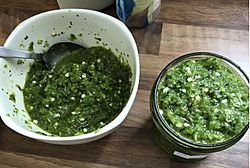Zhug facts for kids

Green zhug
|
|
| Alternative names | Harif, ma'booj, sahawiq, sahowqa, skhug |
|---|---|
| Type | Condiment |
| Place of origin | Yemen |
| Main ingredients | Hot peppers, garlic, coriander |
| Variations | Red skhug, green skhug, brown skhug |
Zhug is a very spicy sauce. It comes from Yemen, a country in the Arabian Peninsula. People in Yemen also call it sahawiq or bisbas. In other parts of the Arabian Peninsula, it is known as ma'booj.
What's in a Name?
The word sahawiq comes from an Arabic word. This word means "to crush" or "to grind." This makes sense because of how the sauce is made.
Different Kinds of Zhug
There are a few different types of zhug. In Yemen, you can find green sahawiq and red sahawiq. There is also sahawiq with cheese, usually made with Yemeni cheese.
Sometimes, people add dried baby sardines to sahawiq. This special kind is called sahawiq wazif.
In Israel, zhug is very popular. You might hear it called skhug. There are three main kinds:
- Red zhug (skhug adom) is made with red peppers.
- Green zhug (skhug yarok) uses green peppers, like jalapeños.
- Brown zhug (skhug khum) has added tomatoes.
People in Israel often call any spicy sauce harif. Zhug is a common topping at falafel and shawarma stands. It is also served with hummus.
How Zhug is Made
Zhug is made from fresh hot peppers. These can be red or green. Other ingredients include coriander, garlic, and salt. Sometimes, people add black cumin and other spices. All these ingredients are mixed with olive oil. Some recipes also include caraway seed, cardamom, and black pepper.
Traditional Yemeni cooks use special stones to make sahawiq. A large stone called marha is the work surface. A smaller stone called wdi is used to crush the ingredients. Today, many people use a mortar and pestle or a food processor. Sometimes, a plant called Pulicaria jaubertii is added.
Images for kids
See also
 In Spanish: Sjug para niños
In Spanish: Sjug para niños


